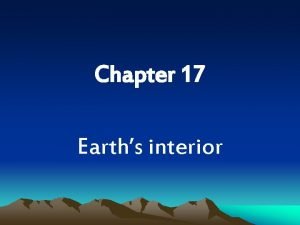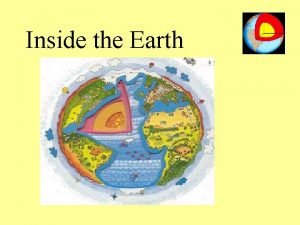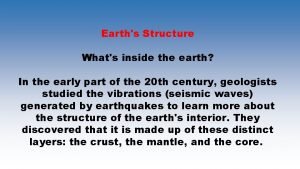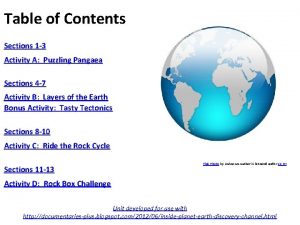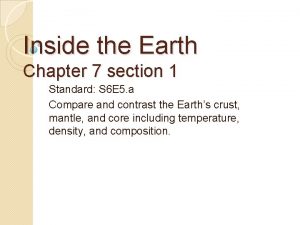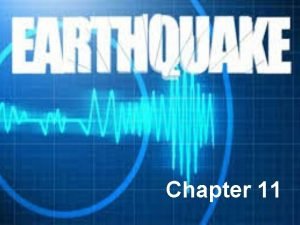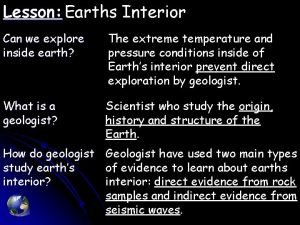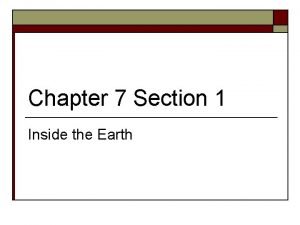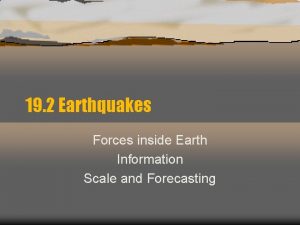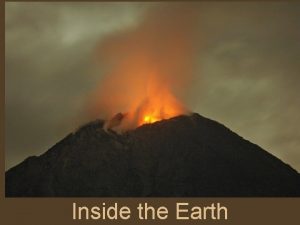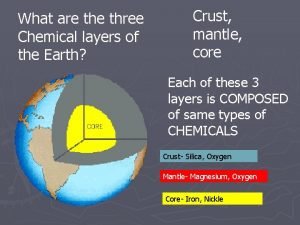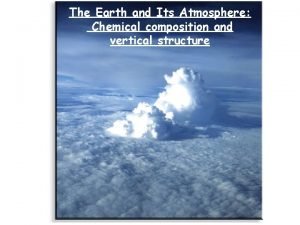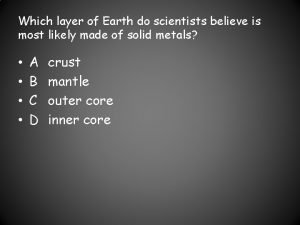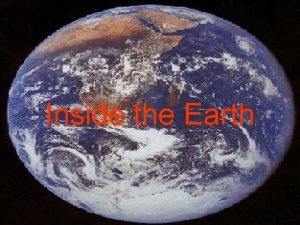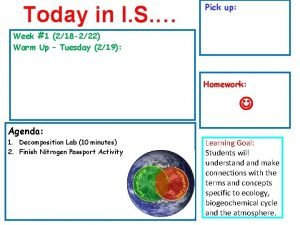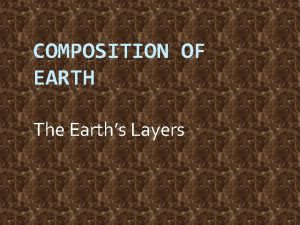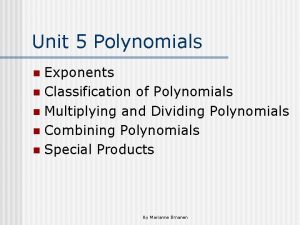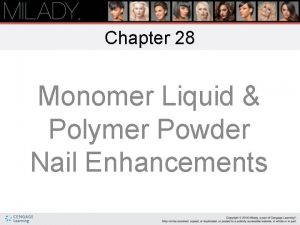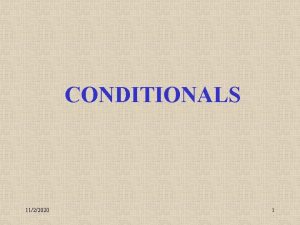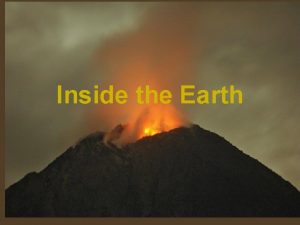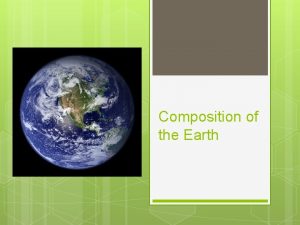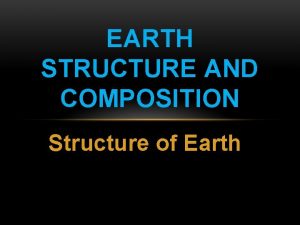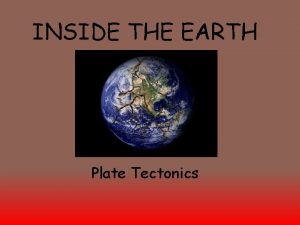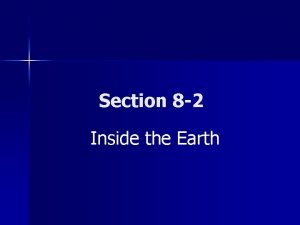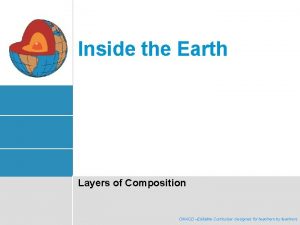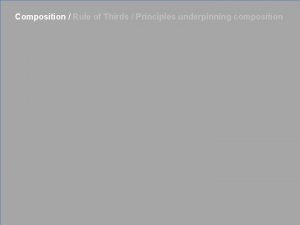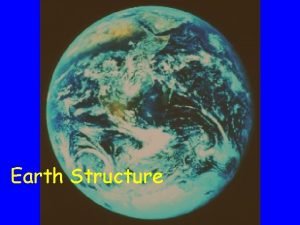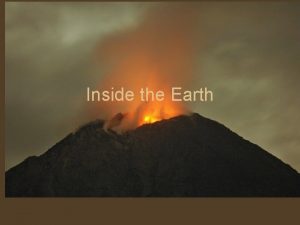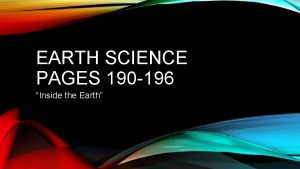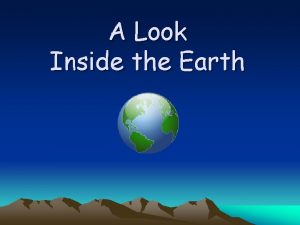Inside the Earth Composition What it is made































































- Slides: 63

Inside the Earth

Composition (What it is made of) • Crust- solid • Mantle- semi-solid • Core – Outer- liquid – Inner- solid


Physical Structure of the Earth (5 Layers) • Lithosphere-solid rigid outer layer (crust) • Asthenosphere- solid plastic like rock that flows slowly (like hot asphalt) • Mesosphere- middle layersolid • Not shown • Outer Core- liquid layer • Inner Core- solid, very dense

What is the Lithosphere? • Rigid, part of the upper portion of mantle and the crust • Broken into tectonic plates • and 100 km thick • Less dense than the material below it so it “floats” on the asthenosphere

What is the Asthenoshere? • The plastic layer of solid rock beneath the lithosphere that has so much heat and pressure the rocks can flow like a liquid • The plates of the lithosphere float on the asthenosphere because it is more dense than lithosphere • The asthenosphere is located about 62 miles beneath the surface of the earth. It has not yet been seen by humans.

ASTHENOSPHERE • Lies right beneath the lithosphere • Layer of rock that is under heat and pressure so it flows like a liquid • They can break apart • More dense than the lithosphere

The Crust • Outer layer • Thinnest layer compared to others • Under oceanic is the thinnest sections of crust • 5 -100 km thick solid • Granite and basalt • 2 types of crust – Oceanic – Continental

2 Types of Plates • Ocean plates - plates below the oceans • Continental plates - plates below the continents

Crust • Oceanic • Continental • very dense, • made of iron (Fe) & magnesium (Mg) and igneous (basalt), • thinner than continental, • more dense than continental • Oceanic crust is also younger* • Layer of Igneous, sedimentary & metamorphic rocks • Form the continents and continental shelves • 25 -70 km thick • less dense, • made of granite • Makes up 1% Earth’s volume



Plate Tectonics

Tectonic Plates • Earth’s crust is broken into about 19 pieces • These plates move on top of the asthenosphere

What is Plate Tectonics • The Earth’s crust and upper mantle are broken into sections called plates • Plates move around on top of the mantle like rafts


Causes of Plate Tectonics

Convection Currents • Hot magma in the Earth moves toward the surface, cools, then sinks again. • Creating convection currents beneath the plates that cause the plates to move.


Questions. . . • What causes plates to move? • How is a convection current formed?

Plate Boundaries

Types • Divergent – Rifting • Convergent – Sub-duction • Transform Fault Boundaries – (Sliding)

Divergent Boundaries • Boundary between two plates that are moving apart or rifting • RIFTING causes SEAFLOOR SPREADING http: //www. pbs. org/wgbh/aso/tryit/tectonics/divergent. html

Divergent Plate Movement: Seafloor Spreading • the movement of two oceanic plates away from each other (at a divergent plate boundary), which results in the formation of new oceanic crust (from magma that comes from within the Earth's mantle) along a a mid-ocean ridge. • Ocean floor spreading was first suggested by Harry Hess and Robert Dietz in the 1960's.


Features of Divergent Boundaries • Mid-ocean ridges • rift valleys • fissure volcanoes




Divergent Boundary • Real Life Example: Mid-Atlantic Ridge • Mid-Atlantic Ridge runs through Atlantic Ocean from Arctic Ocean to an area off the southern tip of South America.



Convergent Boundaries • Boundaries between two plates that are colliding • There are 3 types…

Type 1 • Ocean plate colliding with a less dense continental plate • Subduction Zone: where the less dense plate slides over the more dense plate • VOLCANOES occur at subduction zones

Subduction • Subduction may be defined as the process by which one plate of the earth’s surface shifts so that it moves sideways and beneath a plate located underneath it in the earth’s mantle. http: //www. pbs. org/wgbh/aso/tryit/tectonics/convergent. html


Type 2 • Ocean plate colliding with another ocean plate • The less dense plate slides over the more dense plate creating a subduction zone called a TRENCH

• Two Oceanic Plates - When two oceanic plates collide, one may be pushed under the other and magma from the mantle rises, forming volcanoes in the vicinity

• Two Oceanic Plates - When two oceanic plates collide, one may be pushed under the other and magma from the mantle rises, forming volcanoes in the vicinity

Andes Mountains, South America

Aleutian Islands, Alaska

Type 3 • A continental plate colliding with another continental plate • Have Collision Zones: –a place where folded and thrust faulted mountains form.

• Two Continental Plates - When two continental plates collide, mountain ranges are created as the colliding crust is compressed and pushed upwards.



Transform Fault Boundaries • Boundary between two plates that are sliding past each other • EARTHQUAKES along faults

• When two plates move sideways against each other (at a transform plate boundary), there is a tremendous amount of friction which makes the movement jerky. • The plates slip, then stick as the friction and pressure build up to incredible levels. When the pressure is released suddenly, and the plates suddenly jerk apart, this is an earthquake.


San Andreas Fault, CA


Questions. . . • What are the types of boundaries? • What direction do plates go for each? • Which boundary has a subduction zone…what occurs at a subduction zone?

Pangea. Theory of Continental Drift In the 1800 s, Alfred Wegner developed the Theory of Continental Drift. • He used the following evidence: – Fossils – Climate – Geography


Alfred Wegener Alfred Lothar Wegener, (born November 1, 1880, Berlin, Germany —died November 1930, Greenland), German meteorologist and geophysicist who formulated the first complete statement of the continental drift hypothesis.

• Like certain other scientists before him, Wegener became impressed with the similarity in the coastlines of eastern South America and western Africa and speculated that those lands had once been joined together. • the idea that in the late Paleozoic Era (about 250 million years ago) all the present-day continents had formed a single large mass, or supercontinent, which had subsequently broken apart. Wegener called this ancient continent Pangaea.

Wegener Hypothesis • Wegener proposed that Pangaea’s portions had slowly moved thousands of miles apart over long periods of geologic time. • His term for this movement was die Verschiebung der Kontinente (“continental displacement”), which gave rise to the term continental drift.

Gondwana & Laurasia • He envisioned a single great landmass, Pangaea. Gondwana made up the southern half of this supercontinent. Laurasia made up the northern half of Pangea.

• Gondwana was assembled by continental collisions in the Late Precambrian (about 1 billion to 542 million years ago). Gondwana then collided with North America, Europe, and Siberia to form the supercontinent of Pangea.


Evidence to Back it up • he was able to point to many closely related fossil organisms and similar rock strata that occurred on widely separated continents, particularly those found in both the Americas and in Africa. • By 1930 his theory had been rejected by most geologists, and it sank into obscurity for the next few decades, only to be resurrected as part of theory of plate tectonics during the 1960 s.

• With the mapping of the ocean floor in the late 1940’s, a change of thought began and in the 1960 s it changed when theory of plate tectonics demonstrated that the ocean basins are not permanent global features (sea floor spreading) and vindicated Wegener’s hypothesis of continental drift.

• Seafloor spreading provided a way to explain the movement of continents as the seafloor spreads along the a mid-Atlantic ridge. • The continents bordering the Atlantic Ocean, for example, are believed to be moving away from the Mid-Atlantic Ridge at a rate of 1– 2 cm (0. 4– 0. 8 inch) per year, thus increasing the breadth of the ocean basin by twice that amount.

seafloor spreading in three ocean basins • Patterns of seafloor spreading in the Pacific (left), Arctic (center), and Atlantic oceans (right) showing the relative age of oceanic crust. The youngest regions are colored red, whereas the oldest regions are colored blue.
 Produced from the heat inside the earth
Produced from the heat inside the earth What is inside of earth
What is inside of earth Whats inside the earth
Whats inside the earth Discovery channel inside planet earth worksheet answer key
Discovery channel inside planet earth worksheet answer key Chapter 7 section 1 inside the earth answer key
Chapter 7 section 1 inside the earth answer key Chapter 7 section 1 inside the earth answer key
Chapter 7 section 1 inside the earth answer key Forces inside earth
Forces inside earth Why is the inside of the earth hot
Why is the inside of the earth hot Three compositional layers of the earth
Three compositional layers of the earth Forces
Forces Inside the earth layers
Inside the earth layers Mesosphere earth layer composition
Mesosphere earth layer composition What are the chemical layers of the earth
What are the chemical layers of the earth Structure of atmosphere
Structure of atmosphere Which layer of earth is most likely made of solid metals
Which layer of earth is most likely made of solid metals What is earth made out of
What is earth made out of Edible aquifer lab activity answers
Edible aquifer lab activity answers The four layers of the earth
The four layers of the earth Tư thế ngồi viết
Tư thế ngồi viết Ví dụ giọng cùng tên
Ví dụ giọng cùng tên Thể thơ truyền thống
Thể thơ truyền thống Hát lên người ơi
Hát lên người ơi Hươu thường đẻ mỗi lứa mấy con
Hươu thường đẻ mỗi lứa mấy con Diễn thế sinh thái là
Diễn thế sinh thái là Vẽ hình chiếu vuông góc của vật thể sau
Vẽ hình chiếu vuông góc của vật thể sau Công thức tiính động năng
Công thức tiính động năng Làm thế nào để 102-1=99
Làm thế nào để 102-1=99 Tỉ lệ cơ thể trẻ em
Tỉ lệ cơ thể trẻ em Thế nào là mạng điện lắp đặt kiểu nổi
Thế nào là mạng điện lắp đặt kiểu nổi Lời thề hippocrates
Lời thề hippocrates Vẽ hình chiếu đứng bằng cạnh của vật thể
Vẽ hình chiếu đứng bằng cạnh của vật thể đại từ thay thế
đại từ thay thế Quá trình desamine hóa có thể tạo ra
Quá trình desamine hóa có thể tạo ra Môn thể thao bắt đầu bằng chữ f
Môn thể thao bắt đầu bằng chữ f Sự nuôi và dạy con của hươu
Sự nuôi và dạy con của hươu Hát kết hợp bộ gõ cơ thể
Hát kết hợp bộ gõ cơ thể Dạng đột biến một nhiễm là
Dạng đột biến một nhiễm là Biện pháp chống mỏi cơ
Biện pháp chống mỏi cơ Trời xanh đây là của chúng ta thể thơ
Trời xanh đây là của chúng ta thể thơ độ dài liên kết
độ dài liên kết Voi kéo gỗ như thế nào
Voi kéo gỗ như thế nào Thiếu nhi thế giới liên hoan
Thiếu nhi thế giới liên hoan Phối cảnh
Phối cảnh điện thế nghỉ
điện thế nghỉ Một số thể thơ truyền thống
Một số thể thơ truyền thống Thế nào là hệ số cao nhất
Thế nào là hệ số cao nhất Slidetodoc
Slidetodoc Sơ đồ cơ thể người
Sơ đồ cơ thể người Số nguyên tố là gì
Số nguyên tố là gì đặc điểm cơ thể của người tối cổ
đặc điểm cơ thể của người tối cổ Các châu lục và đại dương trên thế giới
Các châu lục và đại dương trên thế giới Tư thế worm breton là gì
Tư thế worm breton là gì ưu thế lai là gì
ưu thế lai là gì Thẻ vin
Thẻ vin Tư thế ngồi viết
Tư thế ngồi viết Bàn tay mà dây bẩn
Bàn tay mà dây bẩn Các châu lục và đại dương trên thế giới
Các châu lục và đại dương trên thế giới Cách giải mật thư tọa độ
Cách giải mật thư tọa độ Bổ thể
Bổ thể Từ ngữ thể hiện lòng nhân hậu
Từ ngữ thể hiện lòng nhân hậu Degree of a monomial
Degree of a monomial Designs inside a nail enhancement
Designs inside a nail enhancement Organizing from the inside out
Organizing from the inside out Tell him to bring his bicycle inside
Tell him to bring his bicycle inside
